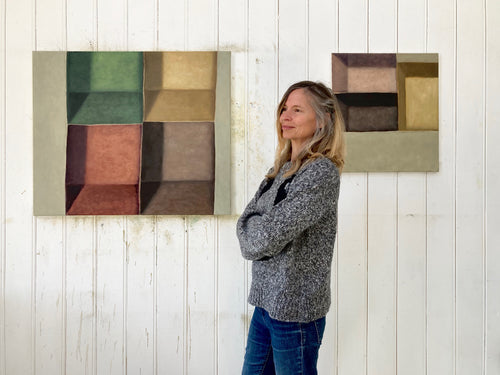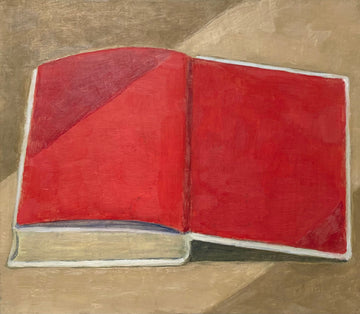MUNTHE ART MONDAY: Jess Allen
Instagram: @jessallenartist
Website: www.jessallen.co.uk
Introduce yourself and what you do.
Painting for me is a meditation. It is the mindful activity of looking. My paintings are observations and contemplations of simple forms, light and space. I hope to convey a sense of stillness and presence.
I am primarily a figurative painter of still lives and landscapes, with my work very much anchored in observation. In my still lives, I paint simple, unremarkable objects, such a paper bags, boxes and books. Through painting these everyday things, and concentrating my interest on their unique qualities, I find, through contemplation of their ordinariness, a simple beauty.
Painting becomes a meditation or appreciation of the everyday, and this really interests me as a metaphor for life, which is enhanced by taking time to have simple focus on simple things. In recent landscapes, I have also noticed how I am automatically drawn to views which are unusual in their ordinariness, or in their 'off the beaten track' quality. Well documented and painted views are not mine. I paint what is rarely appreciated and hidden, away from the well-worn track, a simple field, a view from my studio window, a small copse.
I have an ongoing interest in the abstract, within the seen, and in recent work I have been exploring the crossover between the figurative and the abstract. When observing still life objects, such as groups of boxes or books, I continually see abstract patterns. I find this very interesting, and I am developing a series of almost abstract works, based on boxes and books, which hover in that liminal space, between abstraction and realism.
I now live in the far West of Cornwall near to Lad's End, on a remote farm adjacent to wild and beautiful moorland, as well as dramatic coastal landscape. It is 'Poldark' country. I originally grew up in London, but I studied my degree in Fine Art, at Falmouth School of Art, which brought me to Cornwall. I am married and have two grown up daughters. As well as making my own art, I am business partner in my husband's sculpture business.
Could you explain more about how being a woman has affected your career?
I chose for a while, to concentrate on subjects which had specific female relevance. I wanted to shake up the traditional still life subject, and bring to attention certain 'feminine' objects, and I made a large number of paintings of female shoes, handbags, dresses and hats. I gained interest in these works, with a couple of exhibitions of them. One at London College of Fashion, and one in a gallery in Cornwall. Interestingly and perhaps predictably, both gallery curators were female.
Soon after this we moved to an old farmhouse, in need of renovation. It was a big project, and we concentrated first on creating spaces for our picture framing business, and also my husband's sculpture work. With my own artwork not making any money, I played the traditional female supportive role, allowing my own work to be sidelined. For several years I had no studio, and with young children to look after, I took a considerable break from my own art. When I finally had a studio space to work in, (my daughters were much older), I found, that due to being out of the gallery exhibiting loop for quite some time, it was very hard to gain interest from any galleries. I found that gallery doors were always closed, and I lost so much confidence.
Thinking about this, in retrospect, I do wonder whether my concentration on motherhood, and being an assistant to my husband in his career, had contributed to my not being taken seriously.
Now a woman artist in her 50's, I wonder whether it has become even harder for me. I am not only a female artist, without a good cv, but I am not young anymore.
My own, sitting on the sidelines, has certainly taught me that it is important as a young female artist, to establish oneself in a career sense, before having a family. And then perhaps motherhood can happen alongside an art career. My career had not got off the ground, so I didn't have anything to maintain, and no financial ability to support my creativity.
I am beginning to sense an improved world for women artists. I feel that there is more hope now than ever before, for younger female artists. Particularly as women are becoming more and more active in curating, and gallery management, and they are definitely helping to create so many more opportunities for female artists. Currently in the UK there are many more female artists being brought into the limelight, and this is very good, because it provides role models for young women.
When I was at art school, there were so few female artists working and succeeding in the contemporary art world. The internet and social media have contributed hugely to an awareness of other artists, including women artists. Also, it is possible, as an artist, to take so much more control of one's exposure to the wider world, through personally curating one's own presence on the web. I myself am becoming very active on Instagram, and through it, I am finding connections with female art curators, and doors are at last beginning to open for me.
Women are crucial in supporting each other. There is so much more empathy. Hopefully the Art World is changing and moving towards a greater balance.
Things are beginning to happen. I have shown some of my work in June with the new online gallery Mothflower, and also, Galerie Magnus Karlson, in a summer exhibition ‘Postcard’s’ at Hellvi Kännungs, on the Island of Gotlund.
Can you name some other female (artist) that inspires you and explain why they do so?
I am inspired by the American Artist Georgia O' Keeffe. Particularly because of her singular vision and her commitment to her observed subjects, many still life subjects from the natural world around her, plants, flowers, bones, skulls, and the landscapes, which she painted again and again, in many variations. She created such unusual representations of these and by focusing in on them they bordered on the abstract. I so relate to this concentration, because it so encapsulates the abundance of meaning to be found in quiet observation. I also relate to her because of the remote location where she lived in New Mexico. I too live in a rural area, far away from urbanism, and the gallery art world.
Another woman artist who inspires me, is the Canadian born American Agnes Martin. Like O'Keeffe, she chose to live away from the artistic epicentre of New York. Leaving New York, she too settled in New Mexico, where she was singularly immersed in her work, turning away from the social networking aspect of being an artist. What particularly interests me though, was her deep interest in the spiritual. She embraced spiritual teachings of the East, as well as mystical Christianity. In later years, she also spoke of being inspired by visions to make certain paintings, such as the grids. Certainly, in the presence of many of her paintings, I find that there is a purity and mediative simplicity to them. It does not seem surprising to me, that she spoke of being led to make her work, through what she called 'a gentle spirit'. She spoke of this inspiration saying,
"Inspiration is there all the time. For everyone whose mind is not clouded over with thoughts, whether they realise it or not. Inspiration is pervasive but not a power. It is a peaceful thing.'
I am also inspired by the British painter Winifred Nicholson, the first wife of Ben Nicholson, who was a Christian Scientist, a religion which I was brought up in. She made certain paintings in which she tried to convey the concept of a spiritual nonmaterial realm, which we can access and connect with. The language which she used was abstraction, which was very new at the time when she was making these works. It perfectly suited her belief in an alternative dimension, because it did not convey objects of the real physical world. I admire her for exploring how to visually convey the unseen.
What has been the most challenging aspect of being a female
artist?
For me, having children has been the most challenging aspect of being a female artist. When I had my daughters, I was not in the financial position to afford childcare, and I therefore had to put my painting to one side to look after them. I also had no studio space. Unless a woman's career demands to be kept going, women so often put their family first, either by choice, or because of economics. It has been so socially acceptable to do this, and it is an easy trap to fall into. I certainly did.
Each monday we bring you a new interview with a female artist.
Follow MUNTHE ART MONDAY.









